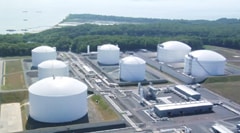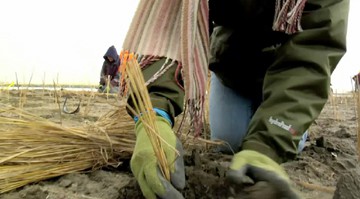Joining Hands to Fill The Breach
A boardwalk leads through pinewoods to the water. From its beginning, you see a sliver of shining Bay. As you walk along the worn planks raised over marshland, the Dominion Cove Point Liquefied Natural Gas facility — the industrial campus, the seven vast blinding-white storage tanks — disappear. At the end, the marsh and the tall reeds give way to the low dunes of Cove Point Beach.
From the beach, you can see across the Bay to Taylors Island. But the view is not uninterrupted. A mile from shore, Cove Point’s other distinctive feature — a half-mile-long dock big enough for two tankers bow to stern — rises like a horizontal metal spine above the Bay.
  |
It’s quite a view, but that’s not why you’re here. This horseshoe stretch of beach has brought you, along with 550 other volunteers, on a vital defense project to ensure the survival of a delicate marshland.
Over four blustery late winter days, volunteers dig and drill 33,000 foot-deep slots, genuflecting into the sand to plant 60,000 brittle sprigs of American beach grass on the dune’s leeward side.
“This is our third bushel,” announces a proud elementary school planter. At noon on the first day, new plantings stretch as far as six school buses all in a row.
Each day, volunteer teams of probers and planters walk the boardwalk to the marsh. Two hundred kids from five elementary schools in Calvert and St. Mary’s counties. A couple dozen Maryland Conservation Corpsmen. Forty of this year’s Leadership Southern Maryland class. Trinity United Methodist Church’s youth group. Neighbors. Citizens. You, energized by the alert in Bay Weekly?
By noon on the fourth day, infant grass spans 3.5 acres of the sloped shoreline, creating a barrier along the northern face of Cove Point, the nub of land that is Calvert County’s easternmost point.
What begins as cold work — with wind whipping the sand in gusts — becomes a satisfying, rhythmic process. You bend and stoop, but you feel good out on the beach, against the sky, seeing what your handiwork is accomplishing.
Behind the dune is a rare freshwater marsh that came close to extinction. Saving it is the task at hand.
The Last Straw
In 2004, Hurricane Isabel made the first puncture into the freshwater marsh. Nature healed that breach. Then in 2006, a particularly vicious Nor’easter set its sights on the Bay. Fifty-knot winds howled, and whitecaps slammed first into the steel supports of the offshore gas dock, then into the beach. Their force divided the spit of land separating the brackish Bay from the delicate freshwater marsh.
“The Nor’easter was the last straw,” said Dominion Cove Point director of operations Michael Frederick. “Bay water was changing the ecosystem.”
A freshwater marsh is an oddity on the Chesapeake. At 190 acres, Cove Point Marsh is the largest freshwater marsh on the Bay’s Western Shore. So distinctive are its geological, hydrological and biological features that Maryland calls it a Maryland Natural Heritage Area.
The daily influx and outflow of tides was on its way to creating a saltwater marsh, a perfectly good but entirely different ecosystem.
“Since the breach in the dunes, there have been significant changes to the animal and plant communities within the marsh,” says Laura Bankey of the National Aquarium in Baltimore, which helped coordinate the plantings.
“Creating the stabilized dune and planting the grasses will give the freshwater marsh a chance to revive,” she says. Even so, whether it will revert to fresh water is an open question that will take a long time to answer.
Had Cove Point Marsh flourished at most any other point along the Chesapeake’s 1,700-hundred-mile shoreline, its fresh water ecosystem would likely have been doomed.
The Back Story

A rescue like this takes human intervention: willpower, time, resources. Cove Point Marsh’s unique location gave it all three.
Cove Point Marsh is the Bay-forward tip of the 1,017 acres of the Dominion Cove Point Liquefied Natural Gas facility. On about 100 acres, the energy colossus Dominion Resources does business as a high-tech receiving port for liquefied natural gas, which is an important three percent of all America’s natural gas, our second largest energy source, behind only petroleum.
LNG tankers from wherever in the world natural gas is flowing — from Latin America to Scandinavia to the Middle East — steam up the Chesapeake. They dock at the skeletal platform a mile offshore from Cove Point to unload their valuable cargo to the storage tanks that are landmarks on Calvert’s shore. At Cove Point, the liquid is warmed back to gas to travel to wherever customers are waiting along an interstate pipeline that stretches from New England to Texas.
Pricing of the commodity plays out across the world as supply and demand fluxuate. Right now, U.S. prices are low, so ships that would have docked at Cove Point go elsewhere in the world, where demand and prices are higher.
Yet Dominion suffers not a bit. Its contracts with British Petroleum and Shell Oil — to receive, store, convert and ship natural gas — are solid, whether 15 ships — last year’s total — or 78 dock.
With the shifting market — and the availability of natural gas close to home, in the Marcellus Shale Formation — Dominion is considering a new angle at Cove Point, exporting American gas to energy-hungry foreign consumers.
“The idea of exporting is in its infancy,” says Dominion spokesman Karl Neddenien. “We have the infrastructure: the tanks, the pier, and we probably wouldn’t need a new pipeline,” added Cove Point director Frederick.
Many Lines of Defense
For now, Dominion Cove Point has time as well as resources and will.
Just as it has gas contracts, Dominion Cove Point also has environmental contracts.
Dominion partners with the Sierra Club and Maryland Conservation Council as the Cove Point Natural Heritage Trust to preserve 80 percent of the property — about 800 acres — as “pristine.” As well, the Nature Conservancy and Maryland Environmental Trust hold conservation easements on the land. Much of the property is managed for scientific studies.
So Cove Point Marsh has champions — and a future.
But the marsh wasn’t rebuilt in a day.
At about the same time the marsh was breached, Dominion had 120,000 cubic yards of Bay bottom on its hands, spoils from dredging at its docking platform. The best way to use it, it turned out, was in Dominion’s own backyard. Strategically positioned Bayward from the vulnerable freshwater marsh, dredge spoils create an 11-acre saltwater marsh as one more line of defense for the freshwater marsh.
With 33,000 tons of rock, a half-mile revetment was built to contain a new brackish marsh. Ten thousand tons of sand were imported to close the breach and reinforce the beach. Salt-tolerant grasses will hold the marsh.
Finally, the last line of defense before the freshwater marsh, the leeward beach, was stabilized with new grasses.
A Marsh for the Future

Sixty-thousand new grasses.
Even mighty Dominion didn’t have enough hands to plant that much grass. Enter a new partner, the National Aquarium in Baltimore.
A lot of the work of the aquarium goes on in its two Baltimore edifices.
But nowadays, the National Aquarium takes environmentalism out from behind the glass exhibits and into the marshes, rivers and tributaries of Chesapeake Bay.
The Aquarium is “working hard to bring conservation from the exhibits to the backyards of Marylanders everywhere,” said Bankey, the biologist who manages the Aquarium’s 10-year-old conservation outreach team, as she walked among the beach grass planters.
That experience made the Aquarium Dominion’s choice to recruit citizen planters whose sweat equity would make them shareholders in the Chesapeake’s future.
Like the Aquarium, the revived Cove Point Marsh is becoming a living classroom. Monitoring stations record conditions in the marsh for study by the scientists at Chesapeake Biological Laboratory. Weirs control water levels to satisfy Maryland Department of Environment’s curiosity about how the marsh works.
“We’ve made a 20-year science project here,” said Dominion chief Frederick.
Cove Point Marsh doesn’t seem to mind scientists. The marsh has room for many species, many purposes.
